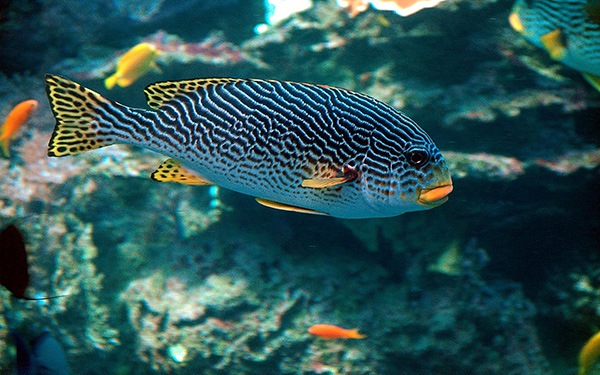Owning a thriving saltwater aquarium is a dream for many aquarists.
While keeping freshwater fish is extremely fun and rewarding, there’s just something magical about the exotic beauty of saltwater fish.
These are the fish that capture our hearts: from the cute Finding Nemo clownfish to the exquisite seahorse, there’s something to interest every fish keeper!
We’ve compiled a guide to the best saltwater aquarium fish and categorized them by care difficulty, so you’ll be able to pick and choose which ones are best for you and your fish tank.
Remember to let us know in the comments if we’ve missed out your favorite!
Saltwater fish for beginners
Ocellaris Clownfish

The Ocellaris Clownfish is the most common and popular in the clownfish family — probably because they’re peaceful and easy to care for, while also bearing a striking resemblance to the main characters in Finding Nemo!
They’re perfect for beginners and a great fish to start off your saltwater aquarium.
- Typical Size: Up to 4″
- Typical Lifespan: 3-6 years
- Breeding: Egg layer, relatively easy to spawn
- Natural Habitat: Asia Pacific
- Optimal Temperature and pH: 73-78°F and 8-8.4 pH
- Optimal Food: Flake, pellet, meat and frozen foods
- Minimum Tank Size: 30 gallons
- Behavior: Peaceful and funny swimmers, may accept host anenomes
- Best Kept: In a community tank, may be aggressive to other clowns
>>> Read our complete Clownfish care guide
Royal Gramma

Royal Gramma basslets are another highly popular breed of colorful saltwater fish that are sure to fit in easily to your aquarium.
They’re beginner friendly thanks to their being small, peaceful and easy to care for. It’s also known as the fairy basslet thanks to its incredible colors.
- Typical Size: Up to 3″
- Typical Lifespan: 3-5 years
- Breeding: Egg layer, relatively easy to spawn
- Natural Habitat: The Caribbean
- Optimal Temperature and pH: 72-78°F and 8-8.4 pH
- Optimal Food: Flake, pellet, meat and frozen foods
- Minimum Tank Size: 30 gallons
- Behavior: Peaceful but can be territorial towards smaller fish
- Best Kept: Alone or in pairs, in community aquarium
>>> Read our complete Royal Gramma care guide
Black Cap Basslet
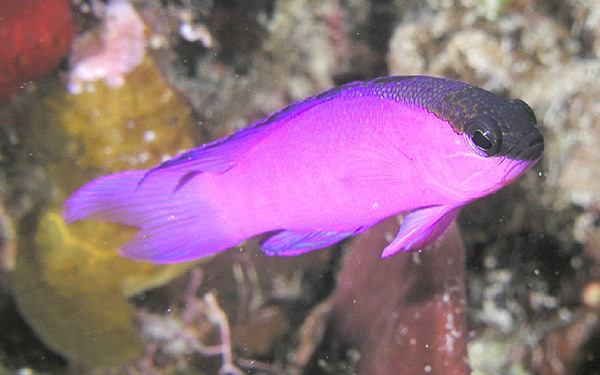
The Black Cap is another basslet that’s a little more unusual than the Royal Gramma, but just as suitable in a beginner saltwater aquarium.
It may be a little more aggressive towards very small invertebrates.
- Typical Size: 4″
- Typical Lifespan: 2-4 years
- Breeding: Egg layer, egg guarders
- Natural Habitat: The Caribbean
- Optimal Temperature and pH: 72-80°F and 8.1-8.4 pH
- Optimal Food: Pellets and meaty food
- Minimum Tank Size: 30 gallons, with lots of live rock
- Behavior: Peaceful but can be territorial towards small invertebrates and aggressive towards other basslets
- Best Kept: Singly with similar sized fish
Snowflake eel

Also known as the Snowflake Moray Eel, these are some of the most commonly kept eels in saltwater fish tanks thanks to their ease of care and docile personalities. They are known for escaping, however, so make sure that you keep that lid on tight.
Plus, we think they’re pretty cute!
- Typical Size: Up to 28″
- Typical Lifespan: 4 years
- Breeding: Egg layer, very difficult
- Natural Habitat: Central America, East Africa and Pacific
- Optimal Temperature and pH: 72-78°F and 8.1-8.4 pH
- Optimal Food: Live and meaty food
- Minimum Tank Size: 75 gallons with secure hood, live rock and cave areas
- Behavior: Docile, most active at night
- Best Kept: Singly, with invertebrates and large, aggressive fish (but not crustaceans)
>>> Read our complete Snowflake Eel care guide
Yellow Striped Cardinalfish
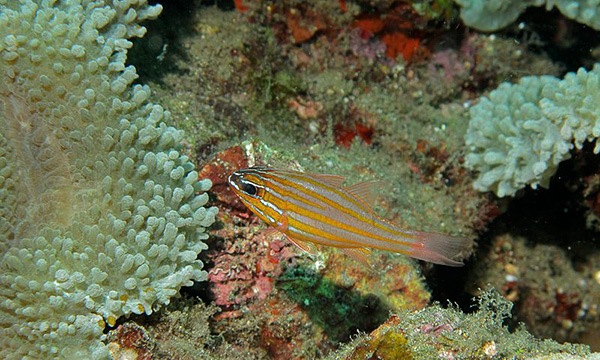
The Yellow Striped Cardinal fish is a small, peaceful and colorful saltwater fish that is very popular among beginner aquarists.
It can be a little shy, so make sure to provide it some hiding areas in sea grass and the like.
- Typical Size: Up to 2.5″
- Breeding: Egg layer, might be difficult to pair
- Natural Habitat: Asia Pacific
- Optimal Temperature and pH: 72-78°F and 8.1-8.4 pH
- Optimal Food: Live, pellet and meaty food
- Minimum Tank Size: 10 gallons with hiding areas
- Behavior: Peaceful
- Best Kept: In pairs or small groups and with other peaceful tank mates
Dottybacks

There are a variety of different Dottybacks available, the most vibrant of which are the Purple and Bicolor Dottybacks. Above is the unique and exotic saltwater fish, the Splendid Dottyback.
It can be a little aggressive in smaller tanks, but otherwise we think it’s a good choice for a committed beginner.
- Typical Size: Up to 3″
- Typical Lifespan: 5-7 years
- Natural Habitat: Southeast Asia
- Optimal Temperature and pH: 72-78°F and 8.1-8.4 pH
- Optimal Food: Meaty food
- Minimum Tank Size: 30 gallons with hiding places and live rock
- Behavior: Can be aggressive in small tanks, will hold its own against larger fish
- Best Kept: With larger, semi aggressive fish
Neon Blue Gobies

There are over 2000 species of goby, and they’re a super popular saltwater fish for many aquariums. Probably the most common — and the one pictured above — is the Neon Blue Goby,
They’re generally pretty peaceful and even provide a parasitic cleaning service if you have any larger reef fish in the tank.
- Typical Size: 2″
- Breeding: Egg layer, will spawn into crevices
- Natural Habitat: The Caribbean
- Optimal Temperature and pH: 72-78°F and 8.1-8.4 pH
- Optimal Food: Live, frozen and meaty foods
- Minimum Tank Size: 10 gallons
- Behavior: Generally peaceful although can be aggressive to other neon gobies if not in a mated pair
- Best Kept: In a mated pair, or singly in small nano reef aquarium
Yellow Tail Damselfish

The Damselfish family are known for their stunning deep blue coloration, and are very popular among saltwater aquarists.
The Yellow Tail variety has exactly that — a yellow tail — plus it’s a little less aggressive than other Damselfish and thus more suitable for beginners.
- Typical Size: 3″
- Typical Lifespan: 15 years
- Breeding: Egg layer, male may become aggressive when caretaking brood
- Natural Habitat: Indo-Pacific
- Optimal Temperature and pH: 72-78°F and 8.1-8.4 pH
- Optimal Food: Meaty food
- Minimum Tank Size: 30 gallons with hiding places
- Behavior: Generally peaceful although might be territorial towards other Damsels and fish of a similar sized
- Best Kept: In odd-numbered groups, with peaceful tankmates
>>> Read our complete Damselfish care guide
Squirrelfish
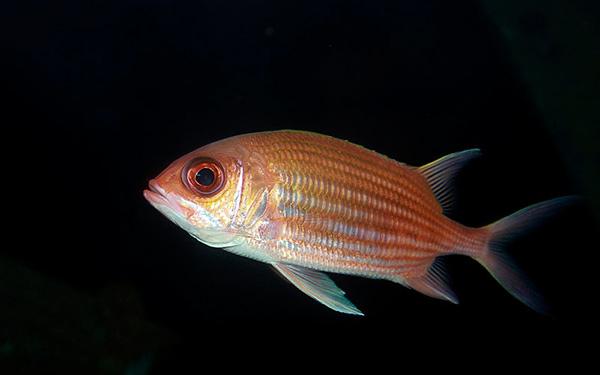
Squirrelfish are a relatively unusual breed of saltwater fish, most distinguishable by their large eyes and the clicking noise they make as they swim.
They’re ideal for beginners as they’re easy to care for and non-aggressive, although they can grow to a reasonable size.
- Typical Size: 8″
- Typical Lifespan: 2-4 years
- Breeding: Egg layer
- Natural Habitat: Indo-Pacific
- Optimal Temperature and pH: 72-78°F and 8.1-8.4 pH
- Optimal Food: Live, freeze dried and meaty food
- Minimum Tank Size: 70 gallons with lots of live rock and strong water circulation
- Behavior: Peaceful and non-aggressive, like to hide and enjoy swimming
- Best Kept: In a small group, OK with mild predators as they stay away from the prominent dorsal fins
Intermediate saltwater fish
Blennies

Similar to gobies in appearance, a Blenny would be a wonderful addition to a saltwater fish tank. There are a huge number of Blenny variations
As they can be a little territorial, we recommend them for intermediate aquarists looking for more of a challenge.
- Typical Size: 4″
- Typical Lifespan: 2-4 years
- Breeding: Egg layer, very difficult
- Natural Habitat: Indo Pacific
- Optimal Temperature and pH: 72-78°F and 8.1-8.4 pH
- Optimal Food: Live, frozen and dried food
- Minimum Tank Size: 30 gallons with hiding places
- Behavior: Generally peaceful although might be territorial towards other Blennies, reclusive
- Best Kept: Singly, in community aquariums
Picasso Triggerfish

How unique looking is the Triggerfish?! They’re known for being able to rotate their eye balls independently too.
There are around 40 different Triggerfish variations, with the one above being the Picasso Triggerfish. We think they’re best for intermediates as they can have a bit of a nasty temper on them, although they are hardy and generally easy to care for.
- Typical Size: 10″
- Typical Lifespan: 5-10 years
- Breeding: Egg layer, very difficult
- Natural Habitat: Indo Pacific
- Optimal Temperature and pH: 72-78°F and 8.1-8.4 pH
- Optimal Food: Live, frozen and meaty food, and hard shelled crustaceans
- Minimum Tank Size: 180 gallons with rocks and caves
- Behavior: Can be very aggressive and territorial in small tanks, clumsy
- Best Kept: With larger, aggressive fish and not in a reef tank
Groupers
Groupers are a popular choice for saltwater aquariums, although they can be a little aggressive so a more experienced aquarist is preferred.
They’re known for their large, stout bodies and drooping mouths. They require lots of space to thrive, as they produce a lot of waste and like open swimming.
- Typical Size: Up to 12″
- Typical Lifespan: Varies but potentially up to 30 years
- Breeding: Egg layer, very difficult
- Natural Habitat: Indo Pacific
- Optimal Temperature and pH: 72-78°F and 8.1-8.4 pH
- Optimal Food: Live, frozen and meaty food
- Minimum Tank Size: 200 gallons with rocks and caves to hide
- Behavior: Aggressive and predatory, especially towards smaller fish and crustaceans
- Best Kept: With large fish and other groupers
>>> Read our complete Grouper care guide
Longnose batfish
The Longnose Batfish is an interesting looking, walking saltwater fish that you’ll find spends a lot of time at the bottom of your tank.
While it’s relatively peaceful, it does have more complex care needs that mark it out as suitable for intermediate aquarists and above.
- Typical Size: Up to 10″
- Natural Habitat: The Caribbean
- Optimal Temperature and pH: 72-78°F and 8.1-8.4 pH
- Optimal Food: Live food, may refuse to eat in aquarium
- Minimum Tank Size: 75 gallons with sand/gravel substrate and dim lighting
- Behavior: Slow moving and docile
- Best Kept: With other peaceful, slow moving tank mates
FoxFace Rabbitfish
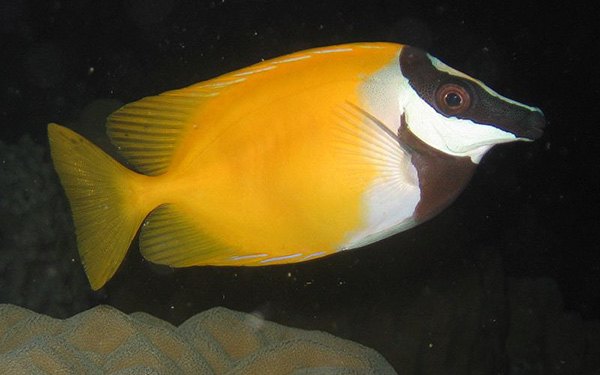
We love this exotic saltwater fish, and truthfully it could be the right fit for a committed beginner’s aquarium, as well as the more experienced.
The reason we’ve put it here, however, is that it requires a large tank and has venomous spines.
- Typical Size: Up to 9″
- Typical Lifespan: 5-7 years
- Natural Habitat: Southeast Asia
- Optimal Temperature and pH: 72-78°F and 8.1-8.4 pH
- Optimal Food: Vegetables and algae
- Minimum Tank Size: 125 gallons
- Behavior: Generally peaceful except around other Rabbitfish
- Best Kept: Singly, with other similarly sized fish, more aggressive fish will leave it alone thanks to venomous dorsal spines
Hawkfish

A beautiful and colorful saltwater fish, the Longnose Hawkfish is a great addition to an intermediate tank.
It is a jumper, so make sure you have a secure lid, and it can be aggressive among others of its kind so best to keep it as a single.
- Typical Size: 5″
- Typical Lifespan: 5-7 years
- Breeding: Egg layer, difficult
- Natural Habitat: Indo Pacific
- Optimal Temperature and pH: 72-78°F and 8.1-8.4 pH
- Optimal Food: Live and meaty food
- Minimum Tank Size: 30 gallons
- Behavior: Aggressive towards other longnose hawkfish and smaller fish
- Best Kept: Singly, with larger fish
Tangs
And here’s Dory from Finding Nemo! This is the Blue Tang.
They’re best for more experienced fish keepers as they require plenty of room and can be aggressive in certain circumstances.
- Typical Size: Up to 1′
- Typical Lifespan: 5 years
- Breeding: Egg layer, very difficult
- Natural Habitat: Indo Pacific
- Optimal Temperature and pH: 75-80°F and 8.1-8.4 pH
- Optimal Food: Live and meaty food, algae and vegetables
- Minimum Tank Size: 180 gallons with plenty of water flow and live rock
- Behavior: Active and great swimmer — hence why they need at least a 6′ tank! Generally peaceful except towards other Tangs
- Best Kept: Singly, or introduced as multiples altogether; may be OK with clownfish
Sweetlips
Sweetlips — a remarkable name for a remarkable fish. The variation picture above is the yellow banded Sweetlips.
They’re part of the Grunt family, and actually make grunting sounds with their teeth and gas bladder. Although they start small, they can grow very large and require lots of open swimming space.
- Typical Size: Up to 24″
- Typical Lifespan: 5 years
- Breeding: Egg layer, very difficult
- Natural Habitat: Indo Pacific
- Optimal Temperature and pH: 75-80°F and 8.1-8.4 pH
- Optimal Food: Live and meaty food
- Minimum Tank Size: 125 gallons
- Behavior: Active and peaceful
- Best Kept: In groups of 4 or more, community aquariums with large tank mates (no crustaceans)
Lyretail Anthias
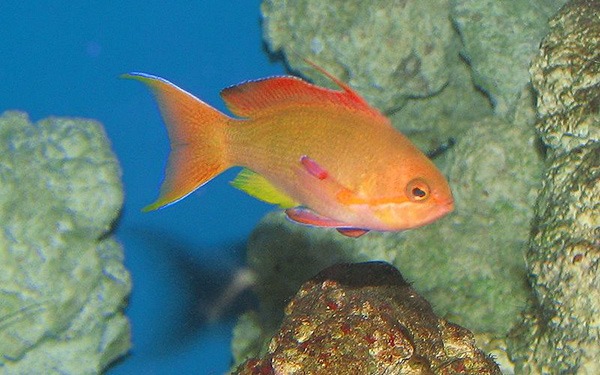
Anthias are a popular and much desired saltwater fish, and we think the Lyretail variation is an excellent pick for intermediate aquarists.
They come in beautiful color assortments, including orange, red and purple.
- Typical Size: 5″
- Natural Habitat: Asia Pacific
- Optimal Temperature and pH: 75-80°F and 8.1-8.4 pH
- Optimal Food: Live, frozen and flake food
- Minimum Tank Size: 125 gallons
- Behavior: Active and sociable; males can be aggressive
- Best Kept: In groups with just one male in species only aquariums
Elite saltwater fish
Cleaner Wrasses
Take a look above at the Cleaner Wrasse in action, doing what they do best.
But keeping a cleaner wrasse alive and thriving in your tank is a very difficult task indeed, so should only be attempted by highly experienced aquarists. These saltwater fish won’t necessarily accept substitute food other than what they can clean off the other fish in your tank so are highly susceptible to starvation.
- Typical Size: 5″
- Natural Habitat: Indo Pacific
- Optimal Temperature and pH: 72-78°F and 8.1-8.4 pH
- Optimal Food: Parasites, fresh and meaty food
- Minimum Tank Size: 70 gallons with secure hood
- Behavior: Peaceful, will set up cleaning stations for other fish to remove unwanted parasites
- Best Kept: Singly, in pairs or groups, tank mates should be dissimilar sized, colorful and thoroughly researched
Lionfish

Lionfish have venomous spines and are predatory so experienced care is a must when handling them in a saltwater aquarium. While it’s unlikely their venom will prove fatal to a healthy adult, young children and those allergic may be at risk.
There are a number of variations — including a dwarf lionfish — but here’s a general information guide:
- Typical Size: 15″
- Typical Lifespan: 5-15 years
- Breeding: Egg layer, very difficult
- Natural Habitat: Indo Pacific
- Optimal Temperature and pH: 72-78°F and 8.1-8.4 pH, requires high water quality
- Optimal Food: Live and meaty food
- Minimum Tank Size: 120 gallons with lots of hiding places and live rock, needs a secure hood
- Behavior: Can be aggressive towards smaller fish, inquisitive but slow moving
- Best Kept: Singly, with other large fish, good for reef aquariums
>>> Read our complete Lionfish care guide
Copperband Butterfly Fish
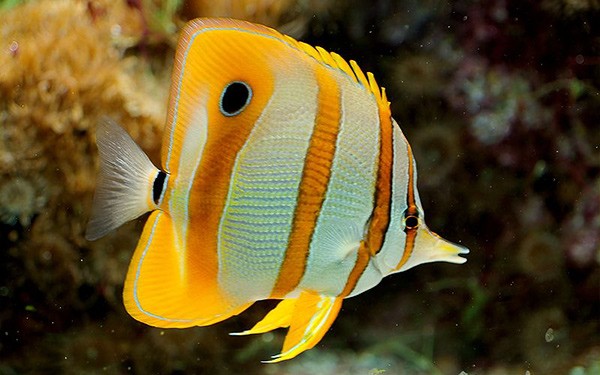
Butterflyfish are some of the most beautiful and colorful freshwater fish we can think of, that can be spotted hanging out among coral reefs when they’re not in a home aquarium!
There are plenty of variations within the Butterfly species, with some of them easier to take care of than others. The Copperband is strictly for elite fish keepers.
- Typical Size: 8″
- Typical Lifespan: Up to 10 years
- Natural Habitat: Asia Pacific
- Optimal Temperature and pH: 72-78°F and 8.1-8.4 pH
- Optimal Food: Needs a variety of different food and can refuse, unlikely to eat pellets and flakes
- Minimum Tank Size: 125 gallons with secure roof
- Behavior: Peaceful, inquisitive, likes a lot of space, prone to injury
- Best Kept: Singly, not with other butterflyfish; best in large reefs and peaceful community tanks
Spiny Box Puffer

Owning a saltwater puffer fish is the goal for many aquarists and the Spiny Box Puffer is considered to be the holy grail.
It does require lots of room for swimming so make sure that you’re prepared to buy a very large tank for it.
- Typical Size: 10″
- Natural Habitat: The Caribbean
- Optimal Temperature and pH: 72-78°F and 8.1-8.4 pH, requires high water quality
- Optimal Food: Varied meaty food and shellfish, can be slow to adapt
- Minimum Tank Size: 180 gallons, fish only tank
- Behavior: Can be nippy towards slow-moving and long-finned fish, not aggressive with other puffers
- Best Kept: Not in a reef tank
Cat Shark

If you are looking to add a catshark to your home saltwater aquarium, you really need to be a highly experienced fish keeper.
Cat sharks can get very large, require plenty of space and can be aggressive to boot.
- Typical Size: 3′
- Natural Habitat: Southeast Asia
- Optimal Temperature and pH: 72-82°F and 8.1-8.4 pH, requires high water quality
- Optimal Food: Can be difficult to get them to eat, live and meaty foods
- Minimum Tank Size: 360 gallons with sand substrate
- Behavior: Can be aggressive, will eat invertebrates, slow swimming
- Best Kept: Singly, not in a reef tank, not with other ground dwellers or fish that will nip at their fins
Dragonface pipefish

This gorgeously unique pipefish is a beautiful addition to a saltwater aquarium, but they can be difficult to care for thanks to their complex feed needs.
Having said that, they’re reasonably easy to keep and peaceful.
- Typical Size: 7″
- Typical Lifespan: 5-8 years
- Breeding: Egg layer, will breed in mated pairs
- Natural Habitat: Asia Pacific
- Optimal Temperature and pH: 72-78°F and 8.1-8.4 pH
- Optimal Food: Live copepods, algae and eventually frozen foods
- Minimum Tank Size: 70 gallons with substrate and large rock to pull itself over
- Behavior: Peaceful, bad swimmers, sociable
- Best Kept: In mated pairs or groups, and with smaller, non-aggressive fish, no large invertabrates
Seahorses

And now we come to what everyone wants in their saltwater aquarium — a seahorse!
Beautiful and unique, these are best kept to experienced aquarists who are content with a seahorse only (and possible pipefish) tank. The most common and easiest to care for is the Kuda seahorse.
- Typical Size: 6″
- Typical Lifespan: Up to 4 years
- Breeding: Egg layer, will breed in mated pairs but hard to raise
- Natural Habitat: Asia Pacific
- Optimal Temperature and pH: 72-74°F and 8.1-8.4 pH, high water quality required
- Optimal Food: Frozen, enriched foods
- Minimum Tank Size: 30 gallons with live rock and lots of hiding places
- Behavior: Peaceful, bad swimmers, shy
- Best Kept: In mated pairs or small groups, in species only tanks (potentially with pipefish and other small, shy fish), no invertebrates
Fiddler Stingray
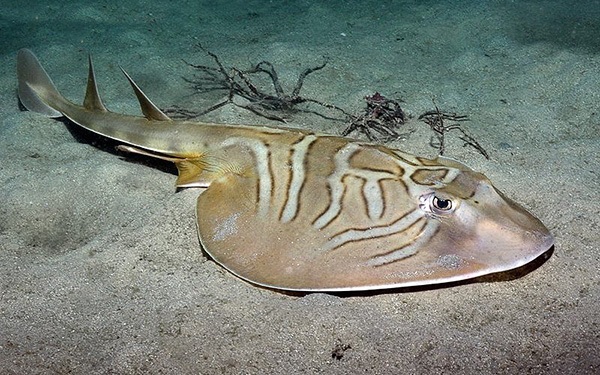
We really wanted to include a ray on this list of the best saltwater aquarium fish, but you should be aware that this is really for very experienced hobbyist level aquarists only.
Not only do you need a huge tank, but you need a lot of patience as these babies have very exacting water quality requirements. Hardy, they ain’t. Plus, you know, they’re venomous.
- Typical Size: 4′
- Typical Lifespan: Up to 10 years
- Natural Habitat: Australia
- Optimal Temperature and pH: 72-78°F and 8.1-8.4 pH, high water quality required
- Optimal Food: Live and meaty foods, will eat crustaceans and molluscs
- Minimum Tank Size: 500 gallons with soft substrate
- Behavior: Generally peaceful
- Best Kept: In fish only tanks with large fish (not ones that will nip at them)
Phew! And there you have it — our complete guide to the best saltwater aquarium fish!
Which is your favorite?



